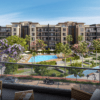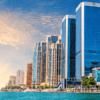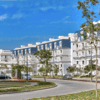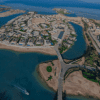Egypt’s ambitious approach to urban development is manifesting through the establishment of fourth-generation cities, aligned with global standards and the nation’s vision for sustainable growth, particularly focusing on the 2030 strategy.
The country has initiated the construction of 14 new urban communities, including notable projects such as the New Administrative Capital (NAC), New Alamein, New Mansoura, and East Port Said.
The combined area of these developments totals approximately 380,000 feddans (acres). This represents a substantial portion of urban development over the past four decades, projected to accommodate 14 million residents and create around 6 million permanent jobs. Such endeavors aim to tackle the pressing challenges of population growth and urbanization while promoting enhanced living standards across the population.
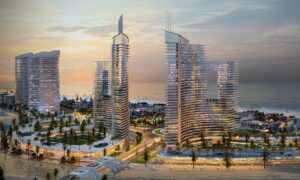
Key Urban Developments
- New Administrative Capital (NAC)
- The NAC is designed to accommodate 500,000 residents in its initial phase. Plans indicate that this number will grow to 6.5 million upon completion. Key governmental offices will relocate here, with projections of employing up to 100,000 government officers.
- This district includes significant infrastructure, such as the Green River Park, spanning 35 km, and an international airport covering 16 km.
- The central area comprises a 1,133-feddan government district as well as medical, sports, and residential facilities, aiming to stimulate local economy and community engagement.
- New Alamein
- Situated along the North Coast, New Alamein is poised as a vibrant tourist and urban hub. With a total area of 48,130 feddans, it is designed to host around 2 million residents.
- The development will include approximately 25,000 hotel rooms, alongside a significant desalination plant capable of producing 100,000 cubic meters of water daily.
- The expansion of the Alexandria-Matrouh road will further facilitate access, promoting both tourism and residential advantages.
- New Mansoura
- This coastal city envisioned to be a prominent living space, spans 5,913 feddans with plans for extensive residential and commercial developments.
- The city’s location near the Mediterranean Sea positions it as a potential tourist attraction, with its first construction phase accommodating 2,063 feddans of residential buildings.
- East Port Said
- East Port Said covers a total area of 23,200 feddans and aims to alleviate pressure on the congested Port Said Governorate by anticipating accommodation for 800,000 residents.
- Its development includes social housing units and a large-scale desalination plant. A comprehensive network of roads and tunnels connects it with surrounding areas, including plans for a metro line to enhance transport connectivity.
- Nasser City in West Assiut
- Located near the airport, the first phase of this city will cater to 345,000 residents and includes essential utilities and social housing projects.
- West Qena
- Encompassing 8,971.1 feddans, West Qena is designed for 550,000 inhabitants. It integrates community services and residential options aimed at improving local quality of life.
- New Ismailia
- With 52,000 housing units, New Ismailia features substantial green spaces and essential infrastructure, focusing on a balanced urban life. The city is geared to support 250,000 residents and incorporates strategic services for community benefits.
- New Rafah and Galala City
- These projects focus on enhancing living conditions with comprehensive service facilities. Galala City additionally concentrates on tourism, employing innovative energy solutions to promote sustainability.
- New Obour and New Toshka
- Both cities aim to connect Cairo’s expanding urban area with suburban developments. New Obour is a proposed extension expected to host about 2.95 million residents. New Toshka, although smaller, intends to support 80,000 residents with light industry and agricultural initiatives.
Goals and Strategies
The overarching goals of these urban projects revolve around promoting sustainable development and addressing the effects of rapid urbanization and climate change. Strategic investments in infrastructure, including roads, public transport, and green spaces, are being prioritized to enhance the resilience and functionality of these new cities.
Sustainability remains at the forefront of urban planning initiatives, with eco-friendly strategies implemented across projects. This includes incorporating renewable energy and water management systems, in alignment with international guidelines for urban sustainability. Measures taken include:
- Green Spaces: Allocating areas for parks and communal spaces, fostering biodiversity, and enhancing residents’ quality of life.
- Efficient Infrastructure: Designing road and transport networks that minimize congestion and promote easier movement within and beyond city limits.
- Innovative Water Solutions: Establishing desalination plants and treatment facilities to ensure water security for these burgeoning communities.
Population and Economic Dynamics
Egypt’s demographic growth continues to yield varying challenges across its cities. The construction of new urban communities is reflective of a national urban agenda that seeks to establish more organized residential configurations, particularly in densely populated regions like Cairo and Alexandria.
The Ministry of Housing and the New Urban Communities Authority (NUCA) play pivotal roles in overseeing these projects and facilitating development plans that target enhanced living standards and economic opportunities. These initiatives are expected to inject significant employment opportunities across sectors, from construction to tourism and services.
Tourism Potential
The focus on cities like New Alamein highlights the inherent opportunities for boosting Egypt’s tourism sector. Proximity to coastlines and historical sites can attract substantial domestic and international tourism. The aim is to create a balanced economy, where tourism complements residential life and provides a strong economic backbone for the cities.
In conclusion, these urban developments underscore Egypt’s commitment to proactive and strategic responses to urban challenges. By investing in sustainable infrastructure and comprehensive planning, Egypt strives to enhance the quality of life for its residents while fostering a resilient future amid the changing dynamics of urbanization.


